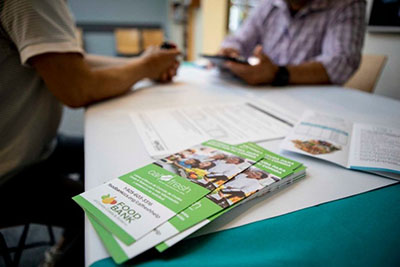- By:
- Category:

Berkeley, CA January 29th, 2021 — A new policy brief released today by the nonpartisan California Policy Lab at UC Berkeley finds that an estimated 500,000 income-eligible households leave the CalFresh program every year. A federal rule requiring most households to verify their eligibility every six months in order to remain in the program is the likely culprit, according to the report’s author.
“Using our most conservative estimates, we find that more than half (55%) of households are likely still eligible when they leave CalFresh,” explains Matt Unrath, the author of the new analysis and a research fellow at the California Policy Lab at UC Berkeley. “People are six times more likely to leave CalFresh in the month that they have to fill out paperwork to confirm their eligibility. While the state and counties could simplify some paperwork burdens, our new research suggests the most effective strategy to address this problem would be for federal policymakers to lengthen the time between eligibility verifications.”
This new analysis suggests that far more eligible households are leaving CalFresh than was previously thought. The state and counties currently use a “churn rate” to track the problem of eligible households leaving CalFresh. This measure estimates that about 15% of people who leave CalFresh in a recertification month will re-enroll within 90 days. However, this measure likely understates the problem of eligible households leaving because it does not include eligible households who re-enroll after 90 days, or who leave CalFresh and never return.
Policy Recommendations
Federal policymakers could minimize the paperwork participants must complete, information they need to provide, and the number of interactions they must have with county staff to remain enrolled.
State policymakers should continue to work with counties to make the interface all recipients use to complete these eligibility verifications more user-friendly; survey counties about best practices; and evaluate which strategies improve retention.
California counties should send additional phone and electronic messages (instead of only postal mail) to remind recipients about reporting deadlines and to communicate with recipients about incomplete, late, or missing paperwork; allow more flexibility for participants to schedule recertification interviews; use available administrative data to verify eligibility; and pilot strategies to reduce paperwork burdens.
Additional background
The California Policy Lab partnered with the California Department of Social Services and the Employment Development Department to conduct the analysis. The new policy brief is based on an in-depth working paper authored by Unrath, which linked de-identified CalFresh enrollment data to wage data from the Employment Development Department in order to calculate participant’s financial eligibility for the program.
CalFresh Statistics
• California has one of the lowest take-up rates in the nation for food stamps, only about 70% of Californians who are eligible for the program actually enroll in it.
• CalFresh benefits are paid for by the federal government, and each month, about four million Californians receive benefits.
• The average monthly CalFresh benefit in California is $250.
•The California Dept. of Social Services has successfully requested that the federal government temporarily waive many CalFresh requirements during the COVID-19 pandemic. For a list of those waivers, visit the USDA website.
The California Policy Lab creates data-driven insights for the public good. Our mission is to partner with California’s state and local governments to generate scientific evidence that solves California’s most urgent problems, including homelessness, poverty, crime, and education inequality. We facilitate close working partnerships between policymakers and researchers at the University of California to help evaluate and improve public programs through empirical research and technical assistance.
This research was made possible through support from Arnold Ventures, The James Irvine Foundation, the University of California Office of the President Multicampus Research Programs and Initiatives, the University of Wisconsin, and the Bylo Chacon Foundation. Support for this research was also provided in part by the Robert Wood Johnson Foundation’s Policies for Action program. The views expressed here do not necessarily reflect the views of the Foundation
Photo credit: Anne Wernikoff for CalMatters
